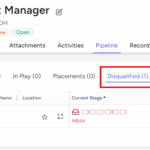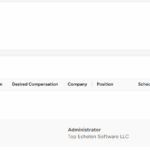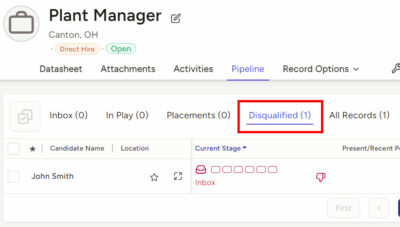One of the most frustrating challenges in the recruitment industry is candidate drop-off. For agency recruiters and search consultants, few things are as disappointing as identifying top talent, guiding them through the initial stages of the hiring process, only to have them disengage or withdraw before reaching the final step. Candidate drop-off is a common issue that can significantly impact your effectiveness, your client relationships, and your bottom line.
Understanding why candidates drop off and how to mitigate those risks is key to improving your placement rates and maintaining client satisfaction. In this article from Top Echelon Recruiting Software, we’ll explore the factors behind candidate drop-off, and we’ll offer proven strategies to reduce it, helping recruiters and search consultants create a seamless candidate experience that encourages commitment and engagement.
1. Understanding the Causes of Candidate Drop-off
Before addressing the problem, it’s important to understand the factors that contribute to candidate drop-off during the recruitment process. By identifying the underlying reasons, you can implement targeted strategies to prevent them.
Common Causes of Candidate Drop-off
- Lengthy Hiring Process: One of the primary reasons candidates withdraw is the length of the hiring process. If the process drags on for too long, candidates can lose interest or accept other offers before your client has a chance to make a decision.
- Poor Communication: Candidates often feel frustrated when communication is inconsistent or unclear. A lack of transparency regarding timelines, next steps, or expectations can lead to disengagement.
- Mismatch of Expectations: If candidates perceive a disconnect between the role as described and the reality of the job, they may drop out. Misaligned expectations regarding salary, job responsibilities, or company culture can lead to early withdrawals from the process.
- Competing Offers: Top candidates are likely to be in demand and may receive multiple job offers simultaneously. Without timely updates or compelling reasons to stay engaged with your role, they may accept other offers.
- Poor Candidate Experience: Candidates judge potential employers based on their experience throughout the recruitment process. A slow, cumbersome, or impersonal experience can deter even the most interested candidates.
- Personal Circumstances: Candidates’ personal situations can change unexpectedly, leading them to withdraw from the hiring process. While these factors are sometimes unavoidable, maintaining strong communication and offering flexibility can help mitigate their impact.
By understanding these common reasons for drop-off, recruiters can take proactive steps to improve their processes and keep candidates engaged.
2. Streamline the Hiring Process
A lengthy, multi-step hiring process is one of the biggest reasons candidates drop off. Talented candidates are often interviewing with several companies at once, and the longer the process takes, the more likely they are to accept another offer or lose interest.
Simplify the Steps
One of the most effective ways to reduce drop-off rates is to streamline the hiring process. Evaluate the existing stages of your recruitment process, from initial application to final offer, and determine if any steps can be eliminated or combined. For example, could preliminary phone screenings and first-round interviews be conducted in one session? Could multiple stakeholders participate in a single interview instead of scheduling separate ones?
Reducing the number of stages in the process will minimize the time candidates spend in limbo and improve your chances of keeping their attention.
Set Clear Timelines
Candidates value transparency, and providing clear timelines can alleviate uncertainty. From the outset, explain each step of the process, how long it will take, and when candidates can expect feedback. For instance, if the initial screening process will take one week, communicate that clearly so candidates know when to expect a response.
Consider setting target deadlines for the entire process, including when interviews should be completed, when decisions will be made, and when offers will be extended. This demonstrates respect for the candidate’s time and keeps the process moving efficiently.
Accelerate Decision-Making
Delays in decision-making often lead to candidate drop-off. When clients take too long to make a final decision, candidates may accept other offers or grow frustrated with the delay. As a recruiter, you can help accelerate this process by:
- Coordinating closely with clients: Help clients understand the importance of timely decisions and offer to assist with scheduling or preparing interview feedback sessions.
- Providing insights on competition: If your client knows the candidate is actively interviewing elsewhere, it can encourage them to expedite the decision-making process.
The faster the process, the less likely candidates will have time to disengage or be poached by other employers.
3. Enhance Communication Throughout the Process
Clear, consistent, and transparent communication is crucial to reducing candidate drop-off rates. Poor communication can create frustration, confusion, and a sense of being undervalued.
Provide Regular Updates
One of the simplest yet most effective ways to keep candidates engaged is to provide regular updates throughout the hiring process. Even if there’s no new information to share, it’s important to let candidates know where they stand.
For example, after each interview round, send a follow-up message thanking the candidate for their time, explaining next steps, and giving them an estimated timeline for feedback. By staying in touch, you reduce the chances of the candidate losing interest or feeling neglected.
Offer Feedback
Feedback is highly valued by candidates, especially if they’ve invested time and effort into multiple rounds of interviews. Providing constructive feedback, even if it’s minimal, shows that you’re invested in their experience and professional growth. It can also build goodwill and strengthen your relationship, making them more likely to continue with the process.
Be Available for Questions
Candidates often have questions about the role, the hiring process, or the company culture. Being responsive and available to address their concerns can help maintain engagement. Consider scheduling a brief check-in call between interviews to answer any questions or clarify expectations. This gives candidates the opportunity to voice concerns before they become disengaged.
4. Align Candidate Expectations Early
A mismatch between candidate expectations and the reality of the role is a common reason for drop-off. To avoid this, recruiters must ensure that expectations are aligned from the beginning of the process.
Provide Accurate Job Descriptions
A well-crafted, accurate job description is essential to setting the right expectations for candidates. Be transparent about the role’s responsibilities, the company culture, the team structure, and any challenges the candidate may face in the position. If there are specific qualifications or skills that are non-negotiable, make that clear early on.
A detailed and honest job description helps prevent misunderstandings that could lead to drop-off later in the process.
Clarify Compensation and Benefits
Salary expectations are often a significant point of contention in the hiring process. To prevent candidates from dropping off due to misaligned salary expectations, address compensation early in the process. Have a frank discussion about the salary range, benefits, and any other financial incentives, such as bonuses or stock options.
It’s important to gauge whether the candidate’s expectations align with what the client is offering. If there’s a discrepancy, address it early on to avoid wasting time or losing the candidate later in the process.
Discuss Company Culture
Culture fit plays a significant role in a candidate’s decision to join a company. If there’s a mismatch in cultural expectations, the candidate may drop off before the final stages of the process. During your conversations with candidates, take the time to discuss the company’s values, work environment, and management style.
If possible, arrange for candidates to meet with potential peers or colleagues during the interview process. This helps them get a feel for the company’s culture and how well they might fit within the team. Ensuring cultural alignment can go a long way in keeping candidates engaged.
5. Improve the Candidate Experience
The candidate experience encompasses every touchpoint a candidate has with your recruitment process. A poor experience can cause candidates to disengage, while a positive one can increase their likelihood of staying committed throughout the process.
Simplify the Application Process
The candidate experience begins with the application process. If candidates find the initial application cumbersome or time-consuming, they may abandon it altogether. Simplify your application process by:
- Limiting the number of required fields: Only ask for essential information during the initial application phase. Additional details can be gathered later in the process.
- Enabling mobile-friendly applications: Ensure that your application process is mobile-friendly, as many candidates may complete the process on their smartphones or tablets.
- Providing clear instructions: Offer candidates clear instructions on how to apply and what to expect after submitting their application.
A simple, user-friendly application process sets the tone for a positive candidate experience.
Ensure a Smooth Interview Process
The interview process is often the most critical stage in a candidate’s journey. Make sure that the process is as efficient, respectful, and engaging as possible by:
- Minimizing wait times between interviews: Long gaps between interview rounds can cause candidates to lose interest. Try to schedule interviews within a short time frame to keep the process moving.
- Preparing interviewers: Ensure that your interviewers are well-prepared and respectful of the candidate’s time. Avoid asking repetitive questions or leaving candidates waiting for extended periods before their interview.
- Offering flexibility: Some candidates may have busy schedules or existing commitments. Offering flexibility in scheduling interviews shows that you respect their time and are accommodating to their needs.
Personalize the Experience
A personalized candidate experience goes a long way in keeping candidates engaged. Address candidates by name in all communications, and tailor your messages to their specific situation. For instance, if a candidate expresses concerns about relocating, address those concerns directly by offering information about the company’s relocation assistance program or providing details about the area.
Personalizing the experience shows candidates that you see them as individuals, not just another name in a pool of applicants. This helps build rapport and keeps them engaged throughout the process.
6. Create a Strong Employer Value Proposition (EVP)
A compelling employer value proposition (EVP) can be a powerful tool in reducing candidate drop-off rates. The EVP communicates why a candidate should choose your client’s company over others, highlighting the unique benefits and opportunities the company offers.
Showcase Career Development Opportunities
Candidates are often motivated by opportunities for growth and advancement. Highlight your client’s commitment to career development, whether it’s through training programs, mentorship, or opportunities for promotion. Candidates who see a clear path for advancement are more likely to stay engaged throughout the hiring process.
Highlight Work-Life Balance
Work-life balance is an increasingly important factor for candidates, especially in today’s remote and hybrid work environments. If your client offers flexible working arrangements, remote work options, or generous vacation policies, be sure to emphasize these benefits. Candidates who prioritize work-life balance will see these offerings as a significant incentive to stay engaged with your client’s opportunity.
Emphasize Company Culture and Values
Today’s candidates want to work for companies that align with their values. Highlight your client’s company culture, mission, and values during the hiring process. Whether it’s a commitment to diversity and inclusion, sustainability, or innovation, candidates who resonate with these values are more likely to remain engaged.
7. Monitor and Measure Drop-off Rates
Finally, to effectively reduce candidate drop-off rates, you need to monitor and measure them. Track where in the process candidates are most likely to drop off and identify patterns. For example, if you notice that candidates often drop off after the first round of interviews, there may be issues with the interview process that need to be addressed.
By regularly reviewing your drop-off rates, you can pinpoint areas for improvement and refine your strategies accordingly.
Reducing candidate drop-off rates is essential for agency recruiters and search consultants looking to improve their placement rates and maintain strong client relationships. By streamlining the hiring process, enhancing communication, aligning expectations, and improving the overall candidate experience, you can significantly reduce drop-off and increase engagement.
Remember that the recruitment process is about more than just filling a role; it’s about building relationships and creating a positive, transparent, and efficient experience for both clients and candidates. By focusing on these key strategies, you’ll position yourself as a trusted partner and stand out in the competitive world of recruiting.








